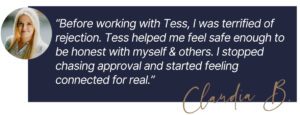Inner child healing sounds abstract until you realize how much of our adult life is run by the feelings of a younger self.
Every time you overextend, withdraw, or find yourself repeating a familiar emotional loop, you’re seeing the child’s old strategies still at work.
Inner child healing is the process of meeting those younger parts with awareness and compassion. It’s not about blaming the past or reliving pain; it’s about understanding that your nervous system and emotional patterns were shaped by what you needed and didn’t receive.
Through this understanding, you begin to re-establish safety for the young one and therefore feel more safe within yourself. In essence, these results come from what therapeutic coaching often calls reparenting or emotional repair.
Table of Contents
Why Inner Child Healing Matters

Healing begins when we allow the child within us to finally feel seen and loved.
As adults, our relationships mirror our past unhealed wounds.
Without addressing the needs of the inner child, we continue to make decisions from unconscious longing: seeking approval, safety, or belonging in the same ways we once did. Until those needs are brought into awareness and met consciously, they quietly drive our choices.
You might pride yourself on independence, always being the one who “does it all.” Or you might struggle to trust others fully.
Both are intelligent survival patterns that protect you from disappointment and betrayal. Yet these patterns keep you isolated. Inner child healing helps you see that those patterns are not flaws but learned responses from a time when you didn’t have the power or safety you needed.
The Patterns We Inherit

Our childhood patterns were creative solutions which kept us safe before they kept us stuck.
At first, the patterns seem obvious: people-pleasing, overachieving, shutting down when others get close. But as you look deeper, the more subtle ones appear like the ways you organize your life around stress, or unconsciously recreate familiar dynamics.
Not Judging the Inner Child Healing
Sometimes the issue isn’t just the difficult person; it’s the enabling or codependent part in you that learned early on to manage others’ emotions to stay safe.
Inner child healing invites you to notice these nuances without judgment.
With compassion, you start to ask questions like, “How is my life set up to cause me stress?” That inquiry turns attention inward, away from blame and toward understanding.
Feeling stuck between heaviness and hope?
Sparks of joy can bring your inner child back to life in a playful way.
💛 GET The JOY Reset: a free, quick-start guide to help you find daily pockets of delight, even on difficult days.
✦ Get The JOY Reset ✦ →
Beyond Coping Strategies

When we soften our grip on survival strategies, space opens for something new to grow.
Many adults have built lives on coping mechanisms that once helped them survive.
Strategies like:
- Overworking,
- caretaking,
- perfectionism…
These all serve as armour that hides a tenderness underneath. Overworking may keep people at arm’s length so we don’t get abandoned again. Or perfectionism may keep us loved by over-performing or perfecting our work.
Inner Child Healing Patterns as Friends
It’s important to remember that however much havoc the old coping mechanism may cause, it’s not bad. Neither you nor the pattern needs to be fixed.
Instead, inner child healing helps you to learn to recognize the intelligence behind your coping:
Of course you reacted that way. Of course you protected yourself. That’s what worked to get you love when you were 8 years old.
Seeing these patterns with compassion allows them to soften. No longer bracing for abandonment, the body can finally rest because the child within finally feels heard “Oh, someone is listening to my big feelings.”
That moment of recognition is what begins true emotional repair.
Healing as Relationship With Self

Healing is the adult self learning to sit beside the child self with calm and care.
At its heart, inner child healing is about building a new relationship with younger you.
It’s the adult self becoming a trustworthy presence for the child self who once had to face too much alone.
Inner Child Healing and Relationships
In time, relationships change, not because people around you become different, but because you relate to them from wholeness instead of unmet need.
You still feel, still risk connection, but now you know you can recover. That is freedom: the ability to open your heart again without losing yourself.
Build on This Understanding

Inner work doesn’t have to be heavy; curiosity and play are part of healing too.
If you’re ready to explore how to bring these insights into the body, learn somatic practices for inner child healing — a companion piece that guides you through gentle ways to regulate your nervous system and begin emotional repair.
Or if you’re beginning here, take your time to let these ideas land.
Inner child healing isn’t a project to complete; it’s a relationship that grows as you learn to meet yourself with the care you once needed most.
Frequently Asked Questions
Q1. What is inner child healing?
It’s the process of reconnecting with the younger parts of yourself that still hold unmet needs, pain, or memories. Through awareness and compassion, you begin to restore safety and trust within.
Q2. Why is inner child healing important?
Because unhealed wounds shape how we love, cope, and connect. Understanding your inner child helps you stop repeating painful patterns and live from choice instead of protection.
Q3. Can anyone do inner child healing?
Yes. It begins with gentle self-awareness and grows over time. Support from a therapeutic coach can help you navigate deeper emotions with care.
Ready to Heal the Relationship Within?
When you meet the parts of you that felt unseen, life opens up again.

